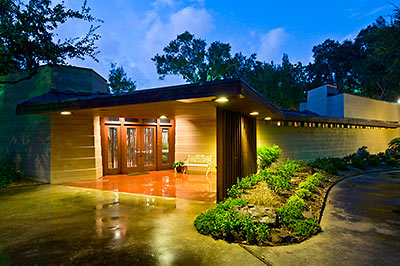
What’s it like inside the only house designed by Frank Lloyd Wright ever built in Houston? The latest edition of the Houston Architectural Guide describes the 1954 Usonian — designed by the master architect for local insurance executive William Thaxton — as “so perverse that it has engendered several sets of alteration intended to make it more livable.” The concrete-block structure featured parallelogram-shaped bedrooms with “claustrophobic proportions.” Among the later additions meant to correct the faults of the “willful and contrary” work of America’s master Modern architect: ionic columns and pineapple-shaped finials on the corners of the roof.
Oh, but all those little problems with the home at the end of a cul-de-sac in Bunker Hill Village have long since been fixed. Author Stephen Fox notes the Guide description was written well before the home’s most recent transformation, designed by Bob Inaba of the local architecture firm now known as Kirksey. In the early nineties the home’s new owners contracted them to wipe away earlier add-ons, then create a long, tall U-shaped annex that hugs the 1,200-sq.-ft. original structure, forming a courtyard with the swimming pool at the center:
***
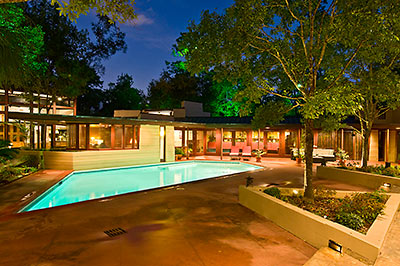
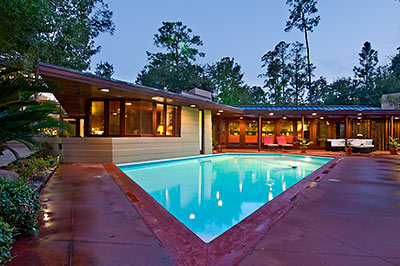
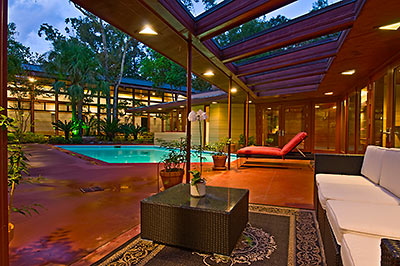
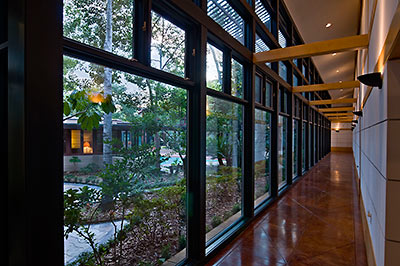
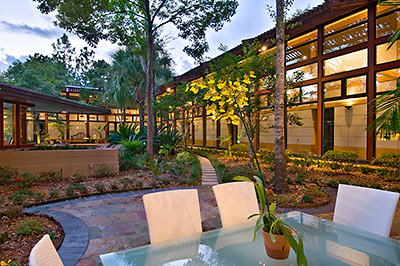
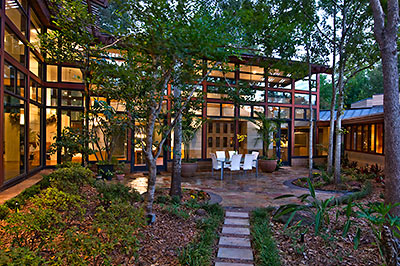
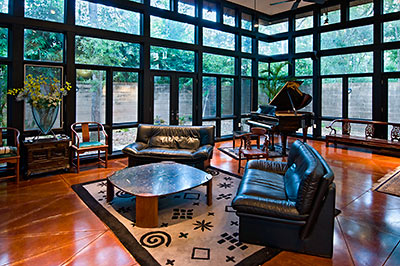
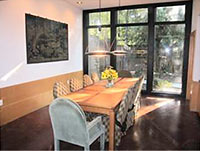
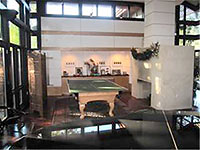
The substantial wraparound addition allowed the home’s new owners to appreciate Wright’s creation without condemning them to live in it: The annex contains entirely separate living and dining spaces, connected by hallways with views of the original structure. And those cramped bedrooms were consolidated into a sitting room, Fox notes.
The owners saved the building — one of only 4 FLW-designed buildings in Texas — from possible demolition when they bought it in 1991 and poured “millions” into the renovation and addition. But they avoided media coverage for their work for many years. Why the recent attention?
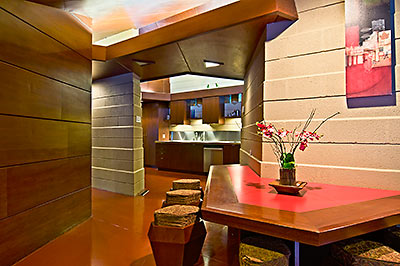
Owner Allen Gaw, a pediatric dentist, tells the Houston Business Journal the once-cramped home is just too big for him now. The whole maybe-10,000, maybe 11,000-sq.-ft. 6-bedroom, 7-1/2-bath house-in-a-house went up for sale last month. He’s asking $3.5 million.
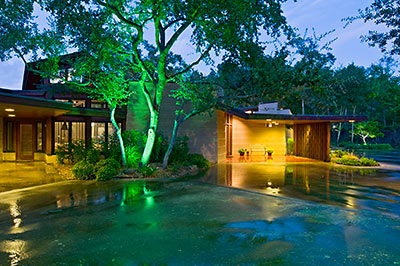
- 12020 Tall Oaks St. [HAR]
- Only Wright house on sales block [Houston Business Journal]
- Houston Journal; A House With a History May Not Have a Future [NYTimes]


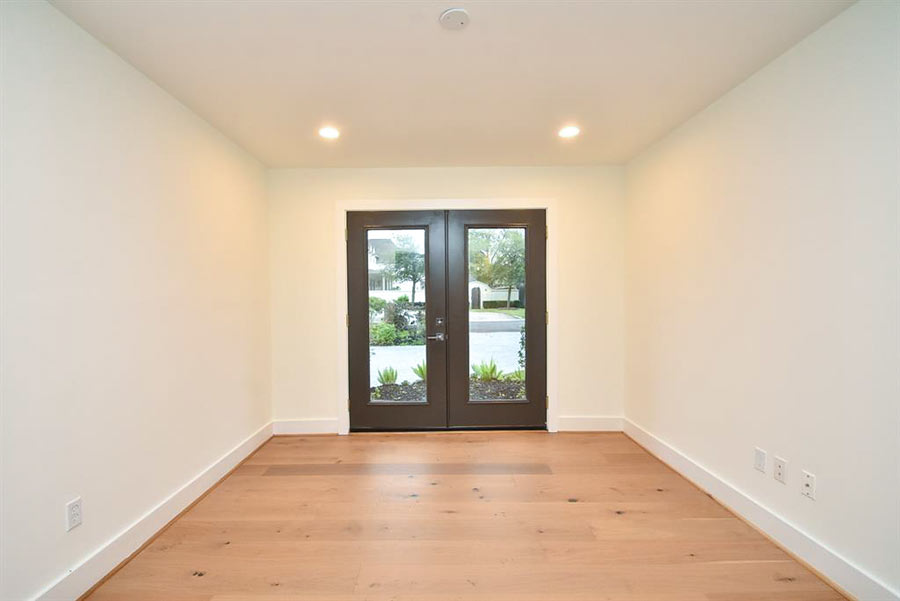
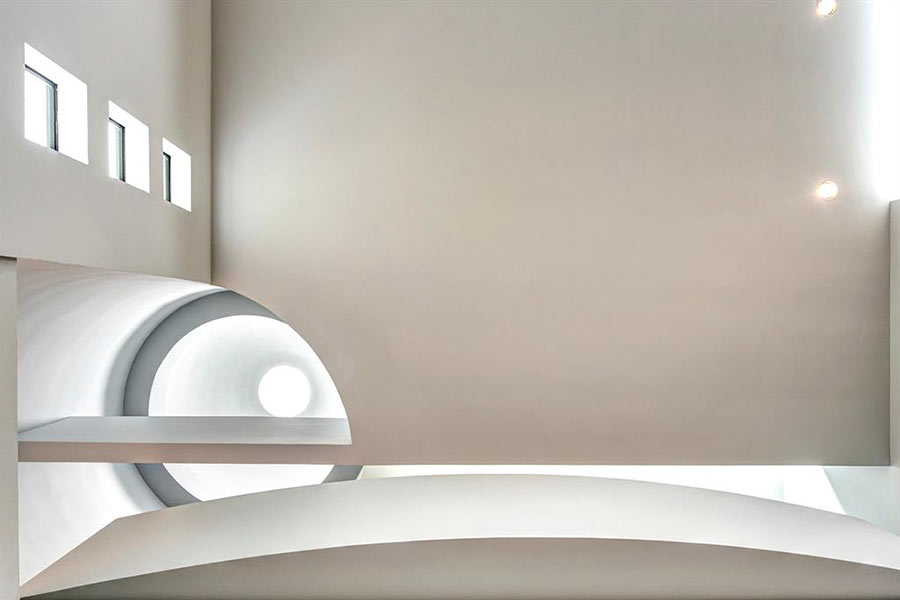
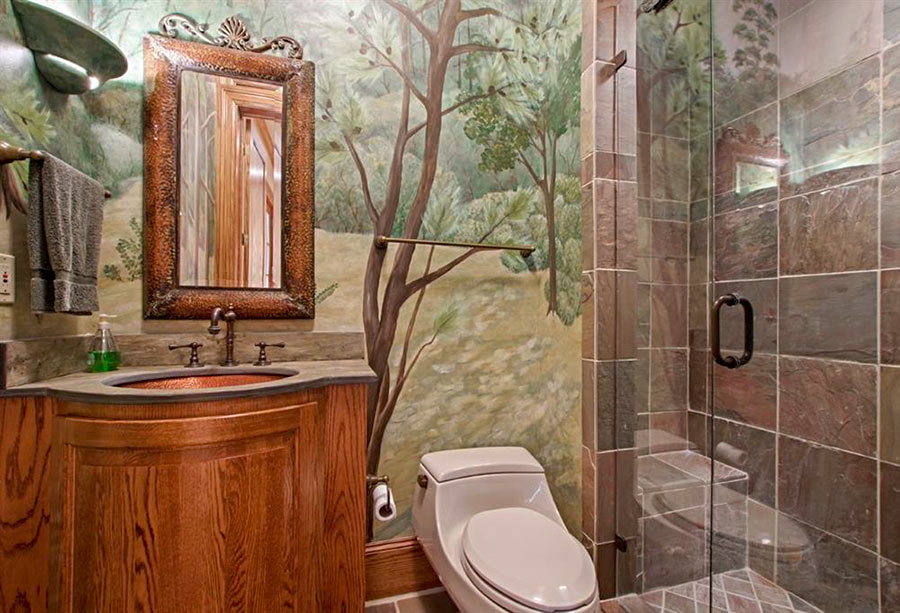
Oooh nice.
What a cool home, hidden in Houston’s real estate jungle!
This place is very big, cumbersome, unwieldy.
What to do, what to do…
.
How about a Home for Unwed Mothers?
With such peace, balance, harmony and daylight!
(and swimming pool)
I’d live here in a heart-beat, though personally beyond procreation…
.
Thank you, Homeowner, for protecting this property.
A little reverie. Forgive me.
So long,
Frank Lloyd Wright.
I can’t believe
your song
is gone
so soon.
I barely learned
the tune
So soon
So soon.
I’ll remember Frank Lloyd Wright.
Architects may come
and
Architects may go
and
Never change your point of view.
When I run dry
I stop awhile
and I think of you.
I’d love to see a floor plan of the original design.
OMG !!! Is the only thing that comes to mind… This house is beyond amazing… Just wish I had the income to buy it… maybe one day… :) … I also wonder what his layouts would be today — I would have loved to see him build a set of townhomes over looking downtown… I see some architects design some but I always feel like they are cookie cutter… they never really take any real chances.. One day a town home builder will make a stance … until then I will dream and keep selling real estate. Good luck to the highest bidder.
Wright designed the Usonian houses to be affordable and efficient and beautiful for a small average American family. They were also supposed to be built as far away as possible from crowded urban centers, which could only happen in an America where most adults had their own car to drive.
The Kirksey addition is lovely, but it sort of ruins the whole original design and soul of the house. Sadly the property values of Bunker Village obviate the possibility that a Wright aficionado or maybe a childless couple could tear down the addition and live simply in the architectural gem that Wright designed.
In one way I think he’s spinning in his grave, but in another he’s probably just happy that he’s being written about regardless of the context. I think this was a brilliant fix to a truely horrible architectural experiment. Only about 60 Usonians were ever built bucause they were unlivable. His goal was to create an affordable home for the average person that cost a maximum of $5,000 to build, but not a single one was built for less than $10,000.
I’m one of his biggest fans but he wasn’t perfect. If he designed townhouses, which he gladly would have if the commission paid, they would have been beautiful but they would have leaked like a seive,gone so far over budget that they probably would never have been finished, and by now would surely have been reduced to a pile of rubble by the climate. He was a brillaint designer and visionary but his creations were far from perfect.
Also, did you know that he expected people to move into his houses without personal posessions? He wanted to control everything right down to the plates and vases. That was as much the downfall of the Usonian designs as anything: Americans are individuals and won’t have their living situations dictated to them.
You can get all of the Usonian floorplans online
I do so wish that someone would moderate the comments on Swamplot for //spam//. Like the thinly veiled advertisements masquerading as comments that some twit of a realtor has taken to posting on Swamplot lately.
I have nothing against realtors–wait, yes I do–but in any case, if you want to hawk your services: buy an ad!
So little of the original house remains that it seems inappropriate refer to it as a Frank Lloyd Wright Usonian. Or a Frank Lloyd Wright anything. As I recall Usonian was a modification of the Prairie design intended for the “middle-class” American. Frank Lloyd Wright works well when the rooms are large enough to carry the wasted space created by the aesthetics. Not so well when they are not. Claustrophobic is probably a good word to use to describe the effect. Aesthetically speaking, Frank Lloyd Wright is, well, divine. Functionally speaking, well, disaster comes to mind in many cases.
This house is an ABSOLUTE Houston/Bunker Hill treasure. I am VERY concerned about the preservation aspect because the city of Bunker Hill does not have a preservation ordinance, I hope whomever the buyer is, they keep the house as is. This is directed to the poster known as SCD, Frank Lloyd Wright died in 1959 at the age of 89 or 90, he was buried at Taliesin Spring Green, Wisconsin, years later his widow, Olgivanna, had his remains exhumed and then cremated, his ashes are now next to hers at Taliesin West, in Scottsdale, Arizona.
I was in this house in the mid-60s and would not even recognize it today. Lovely addition, but it’s a shame they wiped out the original Usonian concept.
Of course nobody is going to tear that house down, and nobody should because it’s beautiful – now. That’s what gets me about the “preservationists”: is it really worth saving something unlivable just because of the architects name, or where it is, or the “feel” id gives an area? If a private individual wants to save it, great, I wish I had $3.5M to save it too because I would. How many people really have that ability and why should it be their responsibility to do it? There are 59 other examples of this impractical house throughout the country on much less valuable land, let those be saved for the sake of saving. I wouldn’t want my tax dollars going to it either because there are a lot more important things for my tax dollars to go to right now. I know all about the man, where he lived, what he built and how he built them. I’ve got more books about him in my library that most libraries. I’m a true admirerer, but these houses didn’t work. Falling Water yes, and if someone wants to adjust their life to lining in his vision, fine, but the best thing about this particular house is the brilliant homage that Kirksey, and the owners, paid to the vision of a great man.
Sorry, I shouldn’t have said “great man” becuase he was actually kind of a s**t (ran out on his wife and 6 kids leaving them deeply in debt, stealing commissions from his trusting employers, theft, confidence games, the list goes on). I should have said “brilliant man”. Unfortunately, it seems that being brilliant, or a genius, and being a s**t go hand and hand. The examples are infinite.
To SCD,
How do you know this … just curious.. I read some to the stuff published on the web, but didnt read anything like that.
Thanks again,
Man. This house reminds me off the FLW house of Mullholland in Donald Hills. Amazing.
With respect to FLR as an architect, philanderer, self-centered/self-promoting a-hole, you can brush-up on all of the aforementioned in an easy to read survey of his life via Wikipedia.
While is work is laudable for its audaciousness, it should be noted that much of what passes for “genius†is actually largely rooted in myth and a carefully managed PR machine (linked to tourism). Wright’s architecture is lavished upon by middle America – due in part to the PR machine – without questioning the underlying, self-aggrandizing nature of the work.
A few of the photos above verify just how unlivable much of his work was (and is… think Guggenheim, Falling Water, to name a few). The Bunker Hill Village Usonian home would be an interesting place to visit, but living there would be another question altogether.
There are a lot of FLW homes in Michigan – now might be a good time to buy up there. There was a cluster in Okemos, MI just a few miles from where I went to college but I never knew about them till much later.
Here is an interesting fan page.
http://www.peterbeers.net/interests/flw_rt/Michigan/michigan.htm
And there is a whole FLW college in FL. They are happy to let you wander the campus, camera in hand. Another fan page
http://mysite.verizon.net/res8sukv/index.html
Crazyness.. Something tells me this guy needs the money. Why else would you give this place up?
Those who prattle on about Wright’s Usonians’
being dark, claustrophobic and unlivable surely have never been in one. Was his personal life a train wreck? Yes. Was he an architectural genius? Without a doubt!
I think it’s worth noting that what many to refer to as FLW’s flaws (with regards to leaks, weather resistance, etc.) are/were simply constraints placed upon him by the technology of the day. Built today, (such as the Usonian-built-design I live in) the homes would not fall prey to such problems. Additionally, the homes are not small/dark/unlivable–frankly (no pun intended!) just the opposite. That is part of the appeal & draw of a Unsonian… it’s openness, it’s feeling of warmth, and it’s oneness with it’s surroundings.
Looks like it’s up for sale again.
http://www.chron.com/homes/article/Frank-Lloyd-Wright-masterpiece-for-sale-in-Houston-5623576.php#photo-6599018
The floorplans in the soon-to-be-built Flats on Fairview seem somewhat Usonian-inspired. Maybe this would be the urban housing FLR might have designed. http://flatsonfairview.com/